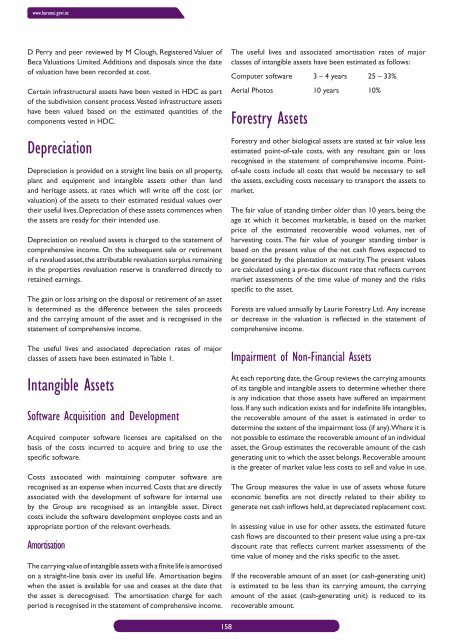Long Term Community Plan 2012-2022 - Hurunui District Council
Long Term Community Plan 2012-2022 - Hurunui District Council
Long Term Community Plan 2012-2022 - Hurunui District Council
Create successful ePaper yourself
Turn your PDF publications into a flip-book with our unique Google optimized e-Paper software.
www.hurunui.govt.nz<br />
D Perry and peer reviewed by M Clough, Registered Valuer of<br />
Beca Valuations Limited. Additions and disposals since the date<br />
of valuation have been recorded at cost.<br />
Certain infrastructural assets have been vested in HDC as part<br />
of the subdivision consent process. Vested infrastructure assets<br />
have been valued based on the estimated quantities of the<br />
components vested in HDC.<br />
Depreciation<br />
Depreciation is provided on a straight line basis on all property,<br />
plant and equipment and intangible assets other than land<br />
and heritage assets, at rates which will write off the cost (or<br />
valuation) of the assets to their estimated residual values over<br />
their useful lives. Depreciation of these assets commences when<br />
the assets are ready for their intended use.<br />
Depreciation on revalued assets is charged to the statement of<br />
comprehensive income. On the subsequent sale or retirement<br />
of a revalued asset, the attributable revaluation surplus remaining<br />
in the properties revaluation reserve is transferred directly to<br />
retained earnings.<br />
The gain or loss arising on the disposal or retirement of an asset<br />
is determined as the difference between the sales proceeds<br />
and the carrying amount of the asset and is recognised in the<br />
statement of comprehensive income.<br />
The useful lives and associated depreciation rates of major<br />
classes of assets have been estimated in Table 1.<br />
Intangible Assets<br />
Software Acquisition and Development<br />
Acquired computer software licenses are capitalised on the<br />
basis of the costs incurred to acquire and bring to use the<br />
specific software.<br />
Costs associated with maintaining computer software are<br />
recognised as an expense when incurred. Costs that are directly<br />
associated with the development of software for internal use<br />
by the Group are recognised as an intangible asset. Direct<br />
costs include the software development employee costs and an<br />
appropriate portion of the relevant overheads.<br />
Amortisation<br />
The carrying value of intangible assets with a finite life is amortised<br />
on a straight-line basis over its useful life. Amortisation begins<br />
when the asset is available for use and ceases at the date that<br />
the asset is derecognised. The amortisation charge for each<br />
period is recognised in the statement of comprehensive income.<br />
The useful lives and associated amortisation rates of major<br />
classes of intangible assets have been estimated as follows:<br />
Computer software 3 – 4 years 25 – 33%<br />
Aerial Photos 10 years 10%<br />
Forestry Assets<br />
Forestry and other biological assets are stated at fair value less<br />
estimated point-of-sale costs, with any resultant gain or loss<br />
recognised in the statement of comprehensive income. Pointof-sale<br />
costs include all costs that would be necessary to sell<br />
the assets, excluding costs necessary to transport the assets to<br />
market.<br />
The fair value of standing timber older than 10 years, being the<br />
age at which it becomes marketable, is based on the market<br />
price of the estimated recoverable wood volumes, net of<br />
harvesting costs. The fair value of younger standing timber is<br />
based on the present value of the net cash flows expected to<br />
be generated by the plantation at maturity. The present values<br />
are calculated using a pre-tax discount rate that reflects current<br />
market assessments of the time value of money and the risks<br />
specific to the asset.<br />
Forests are valued annually by Laurie Forestry Ltd. Any increase<br />
or decrease in the valuation is reflected in the statement of<br />
comprehensive income.<br />
Impairment of Non-Financial Assets<br />
At each reporting date, the Group reviews the carrying amounts<br />
of its tangible and intangible assets to determine whether there<br />
is any indication that those assets have suffered an impairment<br />
loss. If any such indication exists and for indefinite life intangibles,<br />
the recoverable amount of the asset is estimated in order to<br />
determine the extent of the impairment loss (if any). Where it is<br />
not possible to estimate the recoverable amount of an individual<br />
asset, the Group estimates the recoverable amount of the cash<br />
generating unit to which the asset belongs. Recoverable amount<br />
is the greater of market value less costs to sell and value in use.<br />
The Group measures the value in use of assets whose future<br />
economic benefits are not directly related to their ability to<br />
generate net cash inflows held, at depreciated replacement cost.<br />
In assessing value in use for other assets, the estimated future<br />
cash flows are discounted to their present value using a pre-tax<br />
discount rate that reflects current market assessments of the<br />
time value of money and the risks specific to the asset.<br />
If the recoverable amount of an asset (or cash-generating unit)<br />
is estimated to be less than its carrying amount, the carrying<br />
amount of the asset (cash-generating unit) is reduced to its<br />
recoverable amount.<br />
158

















